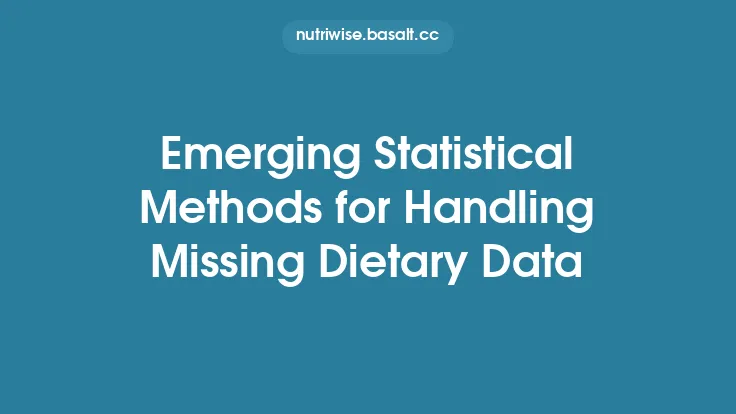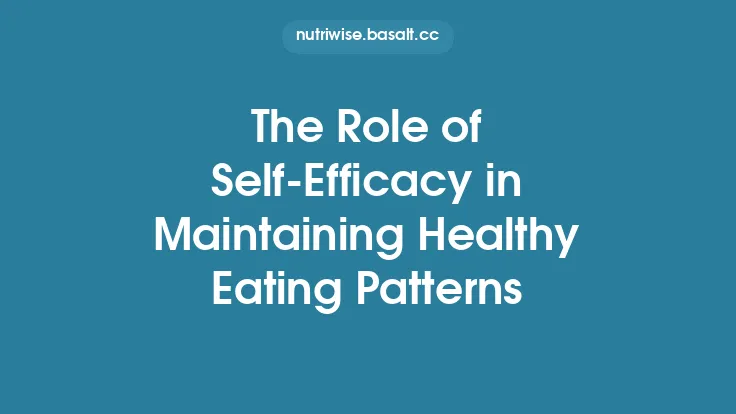The rapid expansion of dietary data—ranging from detailed food logs and grocery receipts to large‑scale national nutrition surveys—has outpaced traditional analytical techniques. While classic methods such as factor analysis or principal component analysis have long been used to summarize eating habits, they often struggle to capture the high‑dimensional, non‑linear relationships inherent in modern datasets. Machine learning (ML) offers a suite of algorithms capable of uncovering hidden structures, modeling complex interactions, and providing predictive insights that were previously unattainable. By integrating these tools into nutrition research, investigators can move beyond simplistic nutrient averages toward a nuanced understanding of how whole‑diet patterns influence health across diverse populations.
Why Machine Learning Is a Game‑Changer for Dietary Pattern Analysis
- Handling High Dimensionality – Contemporary dietary datasets can contain thousands of distinct food items, preparation methods, and portion sizes. Supervised and unsupervised ML models are designed to operate efficiently in such high‑dimensional spaces, reducing the need for aggressive manual aggregation.
- Modeling Non‑Linear Relationships – Health outcomes often respond to diet in a non‑linear fashion (e.g., threshold effects, synergistic interactions). Tree‑based ensembles, neural networks, and kernel methods can capture these complexities without imposing restrictive linear assumptions.
- Scalability – With the advent of cloud computing and GPU acceleration, ML pipelines can process millions of records, enabling population‑level analyses that were previously prohibitive.
- Interpretability Advances – Recent developments in explainable AI (e.g., SHAP values, counterfactual explanations) allow researchers to translate model outputs into actionable dietary recommendations, bridging the gap between “black‑box” predictions and public‑health guidance.
Data Preparation: From Raw Food Records to Model‑Ready Inputs
- Standardizing Food Descriptions
- Lexical Normalization: Convert free‑text entries into a controlled vocabulary using natural‑language processing (NLP) techniques such as tokenization, stemming, and synonym mapping.
- Food Ontologies: Leverage hierarchical food classification systems (e.g., LanguaL, FoodEx2) to group similar items while preserving granularity for downstream analysis.
- Portion Size Quantification
- Image‑Based Estimation: When photographic records are available, convolutional neural networks (CNNs) can estimate portion volumes, which are then transformed into gram equivalents.
- Statistical Imputation: For missing portion data, multiple imputation using predictive mean matching (PMM) or Bayesian hierarchical models can preserve variability without biasing pattern detection.
- Nutrient and Non‑Nutrient Feature Engineering
- Nutrient Aggregation: Compute macro‑ and micronutrient totals per eating occasion, but also retain food‑group counts (e.g., number of fruit servings) to capture dietary diversity.
- Temporal Features: Encode day‑of‑week, seasonality, and meal timing as cyclic variables (using sine/cosine transforms) to allow models to learn periodic eating habits.
- Dimensionality Reduction Prior to Modeling
- Autoencoders: Train unsupervised neural networks to compress high‑dimensional food vectors into low‑dimensional latent representations that preserve essential dietary information.
- Sparse Coding: Apply L1‑regularized matrix factorization to obtain interpretable “dietary atoms” that can be recombined to reconstruct individual diets.
Unsupervised Learning: Discovering Latent Dietary Patterns
| Method | Core Idea | Typical Output | Strengths | Limitations |
|---|---|---|---|---|
| k‑Means Clustering | Partition individuals into k groups based on Euclidean distance in feature space | Cluster assignments | Simple, fast | Assumes spherical clusters, sensitive to scaling |
| Hierarchical Agglomerative Clustering | Build a dendrogram by iteratively merging similar diets | Tree of nested clusters | No need to pre‑specify k, visual interpretability | Computationally intensive for large datasets |
| Gaussian Mixture Models (GMM) | Model data as a mixture of multivariate normal distributions | Probabilistic cluster memberships | Captures overlapping patterns | Requires careful selection of component number |
| Latent Dirichlet Allocation (LDA) | Treat each diet as a “document” of food items, infer “topics” (dietary patterns) | Topic‑food probability matrix | Handles sparse, count‑based data well | Assumes exchangeability of food items |
| Self‑Organizing Maps (SOM) | Project high‑dimensional diets onto a 2‑D grid preserving topological relationships | Visual map of diet similarity | Intuitive visual output | Hyperparameter tuning can be non‑trivial |
| Variational Autoencoders (VAE) | Learn probabilistic latent variables that reconstruct diets | Continuous latent space | Generates synthetic diets for simulation | Requires large training data for stability |
Practical Workflow Example
- Preprocess raw food logs into a binary food‑presence matrix (rows = participants, columns = food items).
- Apply LDA with a range of topic numbers (e.g., 5–20) and evaluate model fit using perplexity and coherence scores.
- Interpret the resulting topics by examining the top‑weighted foods; label them (e.g., “Mediterranean‑rich”, “Processed‑snack heavy”).
- Validate clusters against external variables (e.g., socioeconomic status) to assess plausibility and potential confounding.
Supervised Learning: Linking Dietary Patterns to Health Outcomes
Model Selection
| Algorithm | When to Use | Key Hyperparameters | Interpretability Tools |
|---|---|---|---|
| Random Forest | Moderate‑size datasets, mixed data types | Number of trees, max depth, min samples leaf | Feature importance, partial dependence plots |
| Gradient Boosting (XGBoost, LightGBM) | Need high predictive accuracy, handling of missing values | Learning rate, number of estimators, max depth | SHAP values, tree‑based interaction plots |
| Support Vector Machines (SVM) | Small‑to‑medium datasets, clear margin of separation | Kernel type, C (regularization), gamma | LIME for local explanations |
| Deep Neural Networks (DNN) | Very large datasets, complex non‑linear interactions | Layers, neurons per layer, dropout rate | Integrated gradients, DeepLIFT |
| Elastic Net Logistic Regression | When sparsity and interpretability are paramount | α (mixing parameter), λ (regularization strength) | Coefficient plots, odds ratios |
Training Pipeline
- Split the dataset into training (70 %), validation (15 %), and test (15 %) sets, ensuring stratification by outcome prevalence.
- Perform feature scaling (e.g., robust scaling) on continuous nutrient variables; encode categorical food groups using one‑hot or target encoding.
- Implement cross‑validation (e.g., 5‑fold) on the training set to tune hyperparameters via Bayesian optimization, which efficiently explores the hyperparameter space.
- Assess model performance on the validation set using metrics appropriate to the outcome (e.g., AUROC for binary disease status, RMSE for continuous biomarkers).
- Finalize the model on the combined training + validation data and evaluate unbiased performance on the held‑out test set.
Interpreting Model Outputs for Nutrition Science
- Global Feature Importance: Rank nutrients, food groups, or latent dietary factors by their contribution to model predictions. This highlights which aspects of the diet drive risk or protection.
- Individualized Explanations: Use SHAP (Shapley Additive Explanations) to generate per‑person contribution plots, revealing how a specific participant’s intake of, say, processed meats versus leafy greens influences their predicted disease risk.
- Interaction Detection: Tree‑based models can expose synergistic effects (e.g., high sodium intake amplifying the impact of low potassium). Visualize these with interaction heatmaps derived from partial dependence surfaces.
Model Validation and Generalizability
- External Validation: Apply the trained model to an independent cohort (e.g., a different country or age group) to test transportability. Report calibration plots and decision‑curve analysis to assess clinical utility.
- Temporal Validation: For longitudinal datasets, train on early waves and predict outcomes in later waves, ensuring the model captures evolving dietary trends.
- Robustness Checks: Conduct sensitivity analyses by perturbing input features (e.g., adding random noise to portion sizes) to evaluate model stability.
- Bias Auditing: Examine performance across demographic subgroups (sex, ethnicity, income) to detect systematic disparities. If bias is identified, consider re‑weighting or adversarial debiasing techniques.
Challenges Specific to Machine‑Learning‑Based Dietary Pattern Research
- Measurement Error Propagation – Even after preprocessing, residual inaccuracies in self‑reported intake can bias learned patterns. Incorporating measurement‑error models within the ML pipeline (e.g., Bayesian hierarchical layers) can mitigate this issue.
- High Correlation Among Foods – Multicollinearity can obscure true causal relationships. Regularization (L1/L2) and dimensionality‑reduction methods (e.g., sparse PCA) help disentangle overlapping signals.
- Interpretability vs. Predictive Power Trade‑off – Deep learning models may achieve superior accuracy but are harder to translate into dietary guidelines. A pragmatic approach is to use a “model‑stacking” strategy: combine a high‑performing black‑box with an interpretable surrogate model for communication.
- Computational Resource Constraints – Large‑scale neural networks demand substantial hardware. Leveraging cloud‑based auto‑scaling clusters or employing model compression (pruning, quantization) can reduce costs without sacrificing performance.
- Ethical and Privacy Considerations – Dietary data can be highly personal. Implement differential privacy mechanisms when sharing model parameters or synthetic datasets to protect participant confidentiality.
Emerging Frontiers
- Graph Neural Networks (GNNs) for Food Networks – Represent foods as nodes linked by shared ingredients, culinary techniques, or cultural co‑occurrence. GNNs can learn embeddings that respect these relational structures, offering a richer view of dietary patterns than flat vectors.
- Multi‑Modal Fusion – Combine textual food logs, image‑derived portion estimates, and sensor‑derived timestamps within a unified deep‑learning architecture (e.g., multimodal transformers) to capture the full context of eating behavior.
- Causal Machine Learning – Integrate techniques such as double machine learning (DML) or targeted maximum likelihood estimation (TMLE) with ML‑derived dietary features to move from association toward causal inference, while still leveraging the flexibility of modern algorithms.
- Federated Learning Across Cohorts – Train shared models on decentralized data sources (e.g., national nutrition surveys) without moving raw data, preserving privacy and enabling harmonized pattern discovery across borders.
- Explainable Generative Models – Use variational autoencoders or generative adversarial networks (GANs) to simulate realistic dietary scenarios under hypothetical interventions (e.g., reducing sugar intake), aiding policy simulation and impact assessment.
Practical Recommendations for Researchers
- Start Simple, Scale Up – Begin with interpretable clustering or regularized regression to establish baseline patterns before moving to deep learning.
- Document the Full Pipeline – Record preprocessing scripts, hyperparameter choices, and random seeds to ensure reproducibility.
- Leverage Open‑Source Libraries – Tools such as `scikit‑learn`, `TensorFlow`, `PyTorch`, and `mlr3` provide robust implementations and community support.
- Engage Domain Experts Early – Nutritionists can guide feature engineering (e.g., meaningful food groupings) and help interpret model outputs in a biologically plausible manner.
- Plan for Validation – Allocate a portion of the study budget to external data acquisition or to longitudinal follow‑up, as validation is essential for translating ML findings into public‑health recommendations.
Concluding Perspective
Machine learning has transitioned from a novelty to an indispensable component of modern nutrition research. By adeptly handling high‑dimensional, noisy, and heterogeneous dietary data, ML methods uncover latent eating patterns that traditional techniques often miss. When coupled with rigorous validation, transparent interpretation, and a clear awareness of methodological pitfalls, these approaches empower researchers to decode the intricate relationship between diet and health. As computational resources continue to expand and interdisciplinary collaborations flourish, the next generation of nutrition science will increasingly rely on machine‑learning‑driven insights to inform evidence‑based dietary guidelines, personalized nutrition interventions, and global food‑policy strategies.




